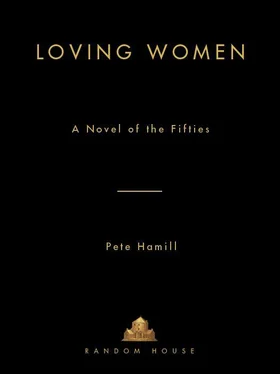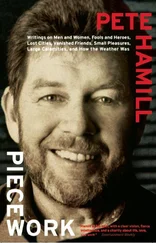I remember clearly the day after she told me she wanted me to draw her, the day after she opened her naked cunt to the breeze of the midnight Gulf. It makes me tremble even now. All that morning, I was like a bundle of jumbled wires. I needed to get to an art supply store, to buy a pad and some chalks. Eden Santana had challenged me, as if she could forgive my youth, my stumbling uncertainties, my awkward poses only if I had talent. So I wanted real tools: chalk, good paper. But I couldn’t go to Sears, couldn’t slide into their art supply section without Eden seeing me. If she saw me buying supplies only for this occasion, she might think I was a fake. Or a dumb boy. Or spying on her. There had to be another place that sold art supplies. In the Pensacola phone book, I found one: Art Land on West Cervantes. I called the store and a woman with a cracker voice told me she closed at five. There was no way I could get there in time. I wasn’t even certain where West Cervantes was. I knew the downtown streets and I could find O Street, but the rest of the city was a blur.
Then Becket came over.
“Take a run to Mainside?” he said.
And I wanted to hug him.
Becket double-parked while I ran into Art Land. The chalks, paints and pens were in drawers behind the counter.
“Kin ah hey-elp yew?” a woman said, coming from behind an aisle. She had a dusty face and weak blue eyes and a disappointed look on her face. A sailor. In dungarees. What could he want?
“Yes, yes,” I said, trying to remember the names of the materials. “I need some charcoal and some of that stuff, you know, the harder stuff, it’s brown or reddish brown?”
“Conté,” she said, bumping around behind the counter.
“And a pad,” I said.
“They’re behind you, right they-uh,” she said. The store was empty of customers and most of the lights were off. From inside, the street was a blinding sun-baked white. “Yew want charcoal paypuh o’ newsprint?”
I didn’t really know. But I looked at the pads, and the prices, and a large newsprint pad was seventy-nine cents and the charcoal paper was two dollars. I picked up the newsprint pad and took it to the counter. “I’ll take this.” She had boxes of Conté crayons and sticks of vine charcoal on the counter. The charcoal looked fragile. She also shoved at me a box of something called compressed charcoal. I picked them up, a stick at a time; the compressed charcoal was heavier and blacker.
“I’ll take two of each,” I said.
“Two of each?” she said.
“Please.”
“Usually we sell them by the box.”
“I know,” I said, “but I don’t really have enough cash on me. I’ll come back and buy the rest of the box, I promise. But I need these right now.”
She sighed in a disgusted way and picked out two each of the vine charcoal, the compressed charcoal and the brown Conté crayons, and made an elaborately sarcastic ceremony of wrapping them. I could hear Becket honking for me. She took her time filling out a bill, listing each item, and then slipped them all into a bag.
“I guess you don’t have enough money for fixative?” she said.
“No,” I said. I didn’t even know what fixative was. The bill was $1.90. I gave her two dollars, waited for my dime and then rushed out to the truck.
“Maybe you drew my picture dat day,” Becket said. “Not Miles.”
“No,” I said. “It was Miles.”
He went roaring down West Cervantes, making up time on his way through midday traffic to Mainside.
“So you’re an artist too?” Becket said.
“Well, sort of,” I said. I explained about cartoons and comic strips, trying to make cartooning sound like an occupation for adults and not something for kids who stayed too long with the funny papers. Milton Caniff made more than a hundred thousand a year, and some guys earned even more. Becket listened and nodded.
“You know,” he said, “you could prolly make some money around the barracks. I remember a guy in Norfolk, he could draw, and he started makin’ pictures from photographs. Two bucks apiece. You know, of different guy’s goirls. Or da guys themselves. And he made him some good money. Not no hundid-thousin a year. Dere wasn’t dat much money in da whole state of Virginia. But good beer money.”
“How’d he start?”
“I guess wit’ one guy. Like da guy dat makes a better mousetrap. The woid gets around.”
“I oughtta try that.”
“Start with me, you want,” he said, as we slowed at the approach to the Mainside gate. “I’ll give you my goirl’s picture later.”
Two dollars a drawing. Until then it had never occurred to me that I could earn money making pictures; that was something for the scary future, when I was out of the Navy. Becket saw things in the present tense. My head teemed with visions of riches.
Late that afternoon, a grizzled mechanic came into the Supply Shack looking for a joy stick. Only Donnie Ray and Harrelson were still at work, filling out forms. I walked to the storeroom, past my desk (where my new art supplies lay flat in the top drawer) and went looking for the joy stick. The storeroom felt gloomy in the fading light. I moved aside pallets and boxes, and found a joy stick in a crate. I went for a dolly, lifted the crate, placed it on the dolly and started to leave. Then, through the new space in the wall of crates, I saw the easel.
There was a painting leaning on the easel, which stood in a tiny room made from improvised walls of stacked crates and boxes. A low crate served as a chair and a second was topped with a sheet of glass upon which were laid tubes of paint and tins of liquid. There were a dozen brushes in a jar and more paintings stacked against the wall. Someone had created a secret art studio here in the Supply Shack. I knew it must be Miles.
I felt as if I’d just entered Aladdin’s cave, piled with treasure. I lifted another crate to fill the space of the one I’d taken and hurried back to the counter with the joy stick. Miles is an artist . I thought about that at my desk, with my own secrets in the drawer, wondering when Miles would be back — he was off to Mainside with Jones and Boswell — and why he had lied to me about the Becket drawing. I waited on a few more customers. Typed forms. Read specification books. All the while anxious to return to the back room, to verify what I’d seen (was this what they meant by a mirage?) and waiting for Donnie Ray to leave. Harrelson had the duty. And he could be a problem; I certainly didn’t want him to discover the studio and invoke the fierce laws of Chickenshit. So at closing time I left, too, and went across the street to the barracks and stood inside the door until I saw Donnie Ray leave.
Then I crossed the street again and opened the middle door, closed it quietly and tiptoed into the back room. I found I could enter the “studio” by flattening myself against the wall and sliding between it and the packing crates. Inside, a single window was covered with a shade tacked to the sill. It was a kind of nest, sealed off, special, private. I felt oddly safe, the way I did when I was a kid hiding under a bush in the park. There was another feeling too: of being in an empty church. I didn’t believe in God, but there was something about the hushed solitude of an afternoon church that always got me. That little cave of packing crates provoked the same awed mood.
The painting on the easel wasn’t finished, but I could see the blocky outlines of a ruined house, a blasted tree, endless green fields moving to a distant blue horizon. It was painted on some kind of heavy board, smooth on the painted surface, coarse on the other. So were all the other paintings. There was a harlequin in a beaded multicolored suit, blue eyes peering from a mask, neither male nor female. Another showed an old woman at the end of a country lane, trees rising above her in a menacing way, her back to the painter. In a third, a man in navy jeans held his head in his hands while a giant orange crowded out everything in the room. The room had screened windows, like the barracks, but there were prison bars beyond the screens, and a small black mask hung from a peg on a wall. There were two pictures of a middle-aged woman with youthful eyes glistening from her sagging face. And a painting of four sailors in Lone Ranger masks standing at the end of a ruined pier with their backs to the sea. I’d never seen pictures like them before. They weren’t like illustrations in Cosmopolitan or McCall’s or like the drawings of Crane and Caniff.
Читать дальше












